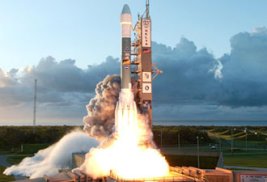

Seven years ago, a spacecraft hitched a ride on a Delta II rocket, and began the long journey to no man’s land. Called Dawn, the spacecraft was designed to explore the asteroid belt, hopefully helping us solve the mysteries of the early solar system in the process. To do so, scientists selected not one, but two targets — Vesta and Ceres — for Dawn to study. This week, Dawn finally beamed back its first views of the dwarf planet Ceres.
For some history… In order to reach its targets in the asteroid belt, Dawn relied on one gravity assist. After flying by Mars on Feb. 17, 2009, the probe reached its first target on Jul. 15, 2011 and departed the asteroid a year later. During these 14 months orbiting, and analyzing the rocky body, it provided unprecedented views of its cratered surface; in addition to uncovering clues about the asteroid’s geological history.
Why Ceres and Vesta?
Ceres and Vesta — the two largest bodies in the main asteroid belt — were chosen partially because they have puzzled astronomers for decades. Ultimately, they were chosen for their similar, yet different characteristics. Vesta is a very dry, evolved body, whereas Ceres is a primitive, wet world. Both bodies are thought to be baby planets, also known as proto-planets, whose formation was disturbed by the neighboring Jupiter.
In order to understand both, Dawn is equipped with a panel of four science instruments, and the same suite of instruments will be used to study both minor planets. The suite is comprised of two cameras, a visible and infrared mapping spectrometer (VIS), capable of revealing surface minerals, as well as a gamma ray and neutron spectrometer (GRaND), used to categorize the elements found in the outer layer of the asteroids.

Scientists hope the data they collect from the mission — things like surface features, gravity fields and varying landscapes — will lead to a deeper understanding of the interior of each world. Additionally, The data will help answer questions such as:
- What role does size have in determining how planets evolve?
- How did water affect the formation process?
Researchers has already enjoyed unprecedented views and data on Vesta, and are anxious to see what Ceres has in store for us. This week, the Dawn spacecraft was able to catch a glimpse of Ceres from a distance of 740,000 miles (1.2 million kilometers) — the best image taken to date of this strange world.

What’s Next?
Scientists are anxious to see images and data from Ceres, especially pertaining to any potentially active hydrological processes, which could lead to seasonal polar caps of water frost.
“Now, finally, we have a spacecraft on the verge of unveiling this mysterious, alien world. Soon it will reveal myriad secrets Ceres has held since the dawn of the solar system,” said Marc Rayman, of NASA’s Jet Propulsion Laboratory in Pasadena, California, chief engineer and mission director of the Dawn mission.
The nine-pixel-wide image of Ceres served as a final calibration of the science camera that will be used when Dawn gets to Ceres. On Dec. 26, Dawn will begin its final approach, and is expected to insert itself into orbit around Ceres early next year.